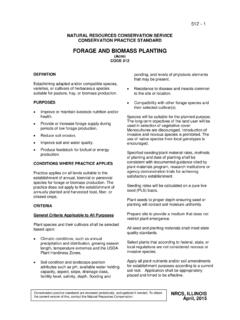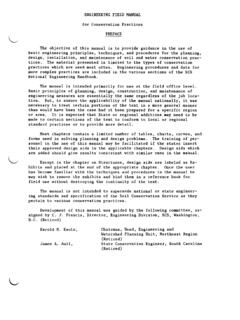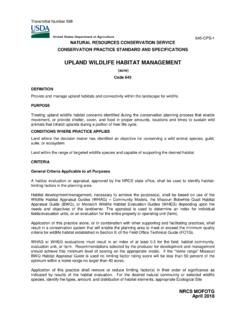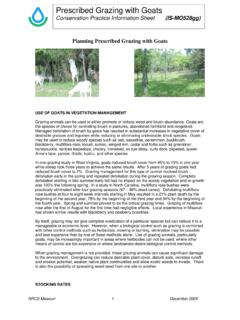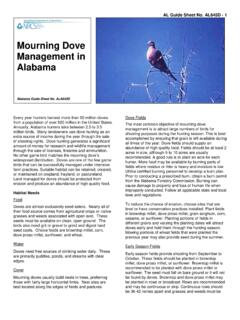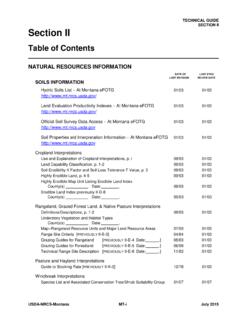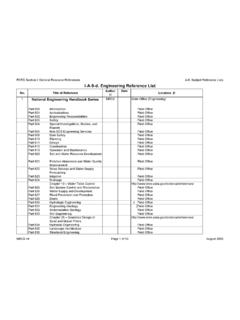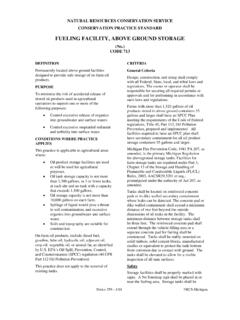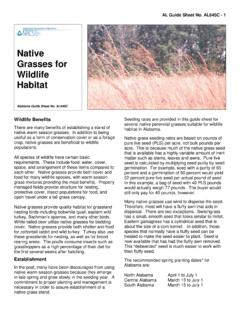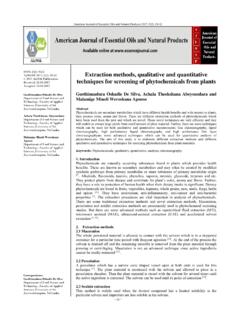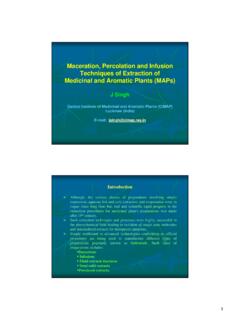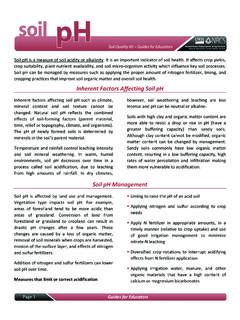Transcription of Chapter 2 Soils - USDA
1 Chapter 2 Soils Contents: General FL2-1. Physical Soil Characteristics FL2-1. (a) Available water Capacity FL2-1. (b) Permeability FL2-3. (c) Intake Rate FL2-3. (d) Slope FL2-4. (e) Wetness FL2-4. (f) Surface Texture FL2-4. (g) Restrictive Features FL2-4. Tables FL2-1 Relative Permeability of Soils FL2-3. FL2-2 Drainage Classes of Soils FL2-4. FL2-3 Soil Texture Abbreviations FL2-4. FL2-4 Irrigation Restrictive Features FL2-5. Figures FL2-1 Soil Moisture Content Types of water in the Soil FL2-2. FL2-2 Moisture Release Curves for Three Soils FL2-2. Exhibits FL2-1 Navigating and Using the Web Soil Survey FL2-6. FL2-2 Navigating and Using the Soil Data Mart FL2-15. (210-vi-NEH, FL Amendment, FL-12, January 2006) FL2-i Chapter 2 Soils Part 652. Irrigation Guide tension for fine to medium textured Soils and General between bar and 15 bar for moderately Knowledge of Soils is essential for the efficient coarse to very coarse textured Soils .
2 AWC of a use of water for crop production. Soil survey soil is primarily related to the soil texture, maps for the areas mapped in the state are now organic matter content, and bulk density. A. available online through the NRCS Web Soil formula for the computation of available water Survey (WSS), capacity is See AWC = (db T Pw)/ (dw 100). Exhibit FL2-1 for instructions on how to use and access the NRCS WSS. The WSS is replacing Where: the familiar, traditional paper copies of soil AWC = Available water capacity in inches survey reports. As new and updated soil surveys are completed, NRCS is distributing the results db = Bulk density of these surveys by means of the WSS instead of = Weight of ovendry soil sample in grams published reports. The WSS allows NRCS to Field volume of sample in cm3.
3 Update the information more rapidly and ensures a single source for official data. Those without T = Thickness of soil horizon under computer access can still acquire soil survey consideration in inches information from an NRCS field office or local Pw = Moisture content between field capacity library. and wilting point in percentage by weight Important physical and chemical characteristics dw = Density of water taken as 1. of each kind of soil are recorded in Soils handbooks or soil survey publications. This There are two methods concerning when to information is also available online through the irrigate. One method is based on the percentage NRCS Soil Data Mart, of AWC within the root zone and the other is See Exhibit based on soil moisture tension.
4 This difference FL2-2 for instructions on how to access and use in concept is shown in Figure FL2-2 which the NRCS Soil Data Mart. Some characteristics shows moisture release curves for three Soils . In of these Soils that are important to understanding this figure moisture content is expressed as a soil-moisture plant relationships are discussed in percentage of AWC rather than a percentage by this guide. They include available water weight. FC is 100 percent of AWC and the WP. capacity, permeability, intake rate, slope, is 0 percent of AWC (15 bars). Tension at any wetness (drainage and depth to water table), and moisture level is different for the three Soils . At surface texture. the 50 percent level, for example, moisture tension for the clay is bars; for the loam, 2.
5 Bars; and for the sand, bars. Physical soil characteristics Moisture is more readily available to plants at low soil moisture tension (near field capacity). Available water Capacity Since tension values are so different in the three The available water capacity (AWC) of a soil is Soils shown in Figure FL2-2, it is possible that a measure of its capacity to make water crop response would be different if the Soils available for plant growth. The AWC is the were irrigated when available moisture depletes amount of water held between field capacity to the 50 percent level. However, for most Soils , (FC) and the permanent wilting point (WP) as irrigation should be started when the soil shown in Figure FL2-1. AWC is expressed as moisture content is no lower than the 50 percent the water retained between bar and 15 bar level.
6 FL2-1 (210-vi-NEH, FL Amendment, FL-12, January 2006). Chapter 2 Soils Part 652. Irrigation Guide Figure FL2-1. Soil Moisture Content Types of water in the Soil Figure FL2-2. Moisture Release Curves for Three Soils (210-vi-NEH, FL Amendment, FL-12, January 2006) FL2-2. Chapter 2 Soils Part 652. Irrigation Guide The NRCS Soil Data Mart can be used to Infiltration is the downward flow of water from generate reports on physical soil properties for the surface through the soil. water enters the Florida Soils , including AWC. For example, the soil through pores, cracks, worm and decayed water holding capacity for 36 inches of rooting root holes, and cavities introduced by tillage. depth on an Alpin soil is: Surface sealing or crusting will restrict infiltration.
7 0'-1', 12 in. = in. Percolation is the movement of water through 1'-2', 12 in. = in. the soil profile. In order for irrigation water to 2'-3', 12 in. = in. be effective in replenishing the Soils water supply, it must be able to move through the Total AWC for 36 in. depth = in. profile, or percolate, to a predetermined The weighted AWC for the rooting depth is irrigation depth. The percolation rate is obtained by dividing the total AWC by the governed by the permeability of the soil or its rooting depth. For the above example, the hydraulic conductivity. Both terms are used to weighted AWC is: describe the ease with which soil transmits water and air. in. = The amount of moisture already in the soil Permeability greatly influences the rate at which water enters Permeability is the quality of soil that enables it the soil.
8 The soil takes in and absorbs irrigation to transmit air and water . It is independent of water rapidly when water is first applied to the the viscosity of water . The permeability of a field surface. As the irrigation application soil is based on the most restrictive layer in the continues, the surface soil gradually becomes soil. The relative permeability of Soils is saturated and the intake rate decreases until it described by the terms listed in Table FL2-1. reaches a nearly constant value. The intake of any soil is limited by any Table FL2-1. Relative Permeability of Soils restriction to the flow of water into or through Term Permeability Rate the soil profile. The soil layer with the lowest (in/hr) transmission rate, either at the surface or directly Very slow < below it, usually determines intake rate.
9 The Slow - most important general factors that influence Moderately slow - intake rate are the physical properties of the soil Moderate - and, in sprinkler irrigation, the plant cover. But Moderately rapid - for any given soil, other factors may affect the Rapid - intake rate. Very rapid >20 Since so many factors affect the water intake, it is not surprising that it varies so much among Permeability rates for Florida Soils are shown as Soils . Furthermore, the intake characteristics of saturated hydraulic conductivity, Ksat ( m/sec) in a given field vary from place to place, from the Physical Soil Properties report in the NRCS irrigation to irrigation, and from season to Soil Data Mart. These values can be converted season. The intake characteristics that must be to for design purposes.
10 Considered in sprinkler irrigation design differ Intake Rate from those for surface methods. Intake rate is a measure of soil's capacity to Actual measured intake rates are unavailable for absorb irrigation water from the surface, and Florida Soils . Intake rates are estimates based on move it into and through the soil profile. It is an the characteristics of the top two feet of the soil. expression of several factors, including If the soil has a water table within two feet of the infiltration and percolation. The term, basic surface, the intake rate is assigned as if the soil intake rate is the rate at which water percolates is drained. Typically, for a well-drained soil, the into soil after infiltration has decreased to a low intake rate is estimated at For other and nearly constant value.

